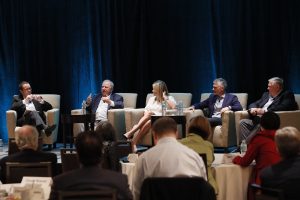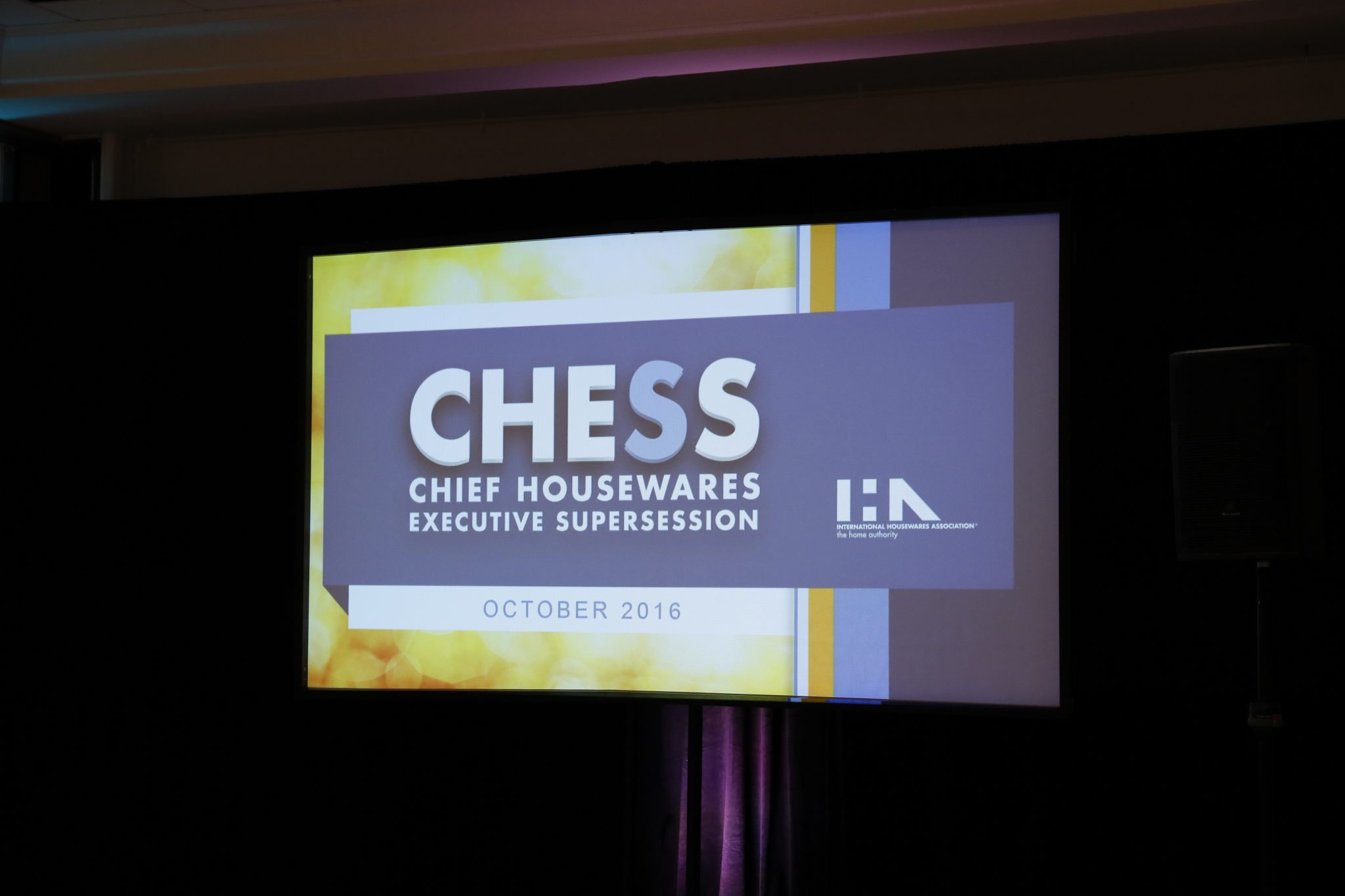Navigating Transitional Times… Through Political, Economic and Cultural Shifts
Chief housewares executives eager to hear the latest from the front lines of the industry learned from experts who addressed IHA’s 2016 CHESS conference on October 6 and 7. The two-day conference, held at the Westin O’Hare hotel, attracts top executives at IHA-member companies who look forward to the varied and fast-paced program. Seven presentations and panel discussions presented the state of the domestic and international conditions. Speakers offered high-level insights into business management in today’s uncertain political and global economic environment, the future of retail and supply chain challenges. This engaging and invigorating conference, now in its 13th year, joins veteran and first-time participants who value building relationships that help build their businesses.

Housewares Hot Seat: Navigating Through Unprecedented Change
The conference began with a provocative conversation among four chief executives who represent a cross-section of categories, business size and ownership format. Peter Giannetti, Editor-in-Chief, HomeWorld Business and Gourmet Insider, moderator, began by outlining some positive figures on consumer confidence and retail sales growth. Panelists Bill Endres, president, Select Brands; Peter Felsenthal, CEO, Whitmor; Melissa Keiling, CEO, PackIt, LLC and Dan Siegel, president, Lifetime Brands, Inc. spoke about how their companies face unpredictability and the challenges in the current retail environment.
Peter began by asking the panelists to introduce their companies and comment about their greatest current concerns.
Peter Felsenthal: Whitmor markets storage and organization products and closet accessories. We are a family-run company with our fourth generation in the business. Today’s challenging uncertain political and economic climate makes difficult to make decisions, but we must take risks. E-commerce disrupted the game for all of us in how we work these channels because a decision in one channel impacts all others, supply chain logistics and pricing. Other challenges include retailers sourcing direct from China and the increasing costs of doing business in China. We are looking at alternative locations and reshoring. Charge backs with retailers are another concern. All of these questions offers opportunities for new directions.
Melissa Keiling of PackIt told about how she started her company that makes foldable freezable lunch bags with an integrated cool pack: Seven years ago, in 2009, I was a mom of three frustrated after a decade of packing lunches for my kids—the freezer packs disappeared and had other problems with inefficiencies. I searched for solutions and figured I’d better do it myself. I researched and sourced materials and constructed a product on my dining table, then found a seamstress to make the bag. Our product is a new concept, so e-commerce works well for us, since the benefits are not obvious to the consumer. Tools like video are very good for us to communicate. One of our issues has been cash flow for startup company because large retailers are not eager to take a risk on something new.
Dan Siegel, Lifetime Brands: We primarily are in the food prep, tabletop and home décor categories. We started as a family business and are now publicly traded. I grew up in this business at 10 years old—I put catalogs together. So I’ve seen both sides, from small family company to a large one. It seems that the pure-play online, off-price, and grocery areas are doing better. Other segments are facing challenges, especially brick and mortar are having trouble getting people in the store. These are challenging and exciting times, particularly in learning how to use online commerce to fill consumer needs.
Bill Endres, owner of Select Brands, outlined that the company is in the small appliance category: We started with private label, then transitioned to our own brands and licensed brands. We’re located in Midwest and family owned. I think the industry dynamics show that we are in the largest transition time ever. I’ve seen a lot of retailers come and go, e-commerce is making many stores disappear, while retail outlets have grown dramatically, one million new square footage in 10 years while e-commerce grows. This is unsustainable.
Giannetti’s initial question set the program’s pace: How do you balance sales and marketing to optimize brick and mortar and build a manageable strategy for e-commerce?
Kieling: We started with a trade show and met Target. That was my “aha moment” to see how different it is. Target was concerned that the consumer wouldn’t understand this product at a premium retail price point and passed on the product. I knew we needed something creative, and we invested in a 2.5-year direct response campaign. This became self-funded marketing campaign to engage consumers at home. The Bed Bath Beyond buyer’s children found out about it. This campaign helped us gain retail placement and build brand awareness. Online gave us the opportunity because consumers would not be able to see that story at the point of sale. We learned that packaging must tell the story at a glance at a retail POS display to communicate product benefits and features.
Endres: Electrics are very competitive, we need to create and build differentiation that sticks. How do we control the digital space, how do you navigate and optimize private label and online? Change is inevitable. We can fight change or embrace it. What are the alternatives? Statistics on e-commerce show that today’s 20% sales generated is expected to grow 40% in five years. Look at that market or else you lose. Brick and mortar retailers try to build relationships, but are tight on inventory space and struggle to build foot traffic in the stores. They learn to marry it, cut back on inventory and use the internet to show a variety of goods to order and for quick delivery. We can take a large appliance off the shelf, a shopper doesn’t have to take the product out to her car, she can have it delivered. Licensing allows us to work differently than with B&M. It’s a transitional period and we must identify opportunities.
Gianetti: Take us through how to control and participate in the business.
Siegel: E-commerce doesn’t have to be the Wild West; it takes fundamental change to take back control. Where do you want to see your products? Amazon is the #1 search engine, not Google. If you’re not there, you’re not real. Clean that up, sell to Amazon directly and not third-party sellers where you lose control of your brands. Manage your brands, clean up third party sellers. Manage the business, Amazon is the key player, work with them to maximize your content and ratings, what consumers see, what will translate to other retailers. Monitor counterfeits and fake reviews. We’ve shifted resources to content development, work on packaging and retrain category managers. Think digital –more information will feed the rest of the organization in B&M. Don’t think B&M first. Online may be 20% now, but 80% of consumers search online first and then shop in person searches, so that 20% will grow, must be conscious of digital searches first. Consumers start there first.
Felsenthal: Our categories are not intuitive for benefits to consumers. How do you build a culture in your organization to invert the process? How you go to market? It’s not easy. I suggest you build your own culture, or it will build itself for you. The digital world and focus on B&M are different business units. We have been careful not to build silos, each part influences the others. We protect our B&M customers as much as possible, and we are conscious of how decisions will impact them. Collaborate with business units to consider this. Bring in appropriate talent to handle the challenges, we have ramped up our digital talent. The challenge to get B&M to focus on digital.
Kieling: Consumer interaction is growing, it’s a two-way conversation. Be authentic and transparent. They are writing comments, be the first responder to create a brand image in front of the world, get instant feedback.
Giannetti: Counterfeit and potentially staged reviews are a problem. Policing that space online is the challenge for the industry, as well as the third party marketplace—how to deal with not just knock-offs, but counterfeits that represent as your product. What about the potential for reviews built on these products, when someone believes it’s your products. How to address with customer base?
Siegel: Reviews are a major problem. We instruct everyone in our company that if you respond to negative comments, you must identify yourself. It’s frustrating to discover fake reviews, negative consumer comments, and that false products are propped up to be #1 best sellers. In order to find out what’s real, we use the fake spot website. I did this for my competitors, we know the names of 82% reviews are considered fake.
Illuminate the issue with Amazon. They have simple solution: verify reviews from purchasers. Building systems for them too. Don’t have an answer for counterfeit. Some of our brands are often counterfeited. We’ve spent $500,000 in litigation. We are diligent and go after them.
Keiling: It’s a hard problem to solve a problem with retailers. We have a strong relationship with Amazon and they are willing to look into it.
Endres: We rely on verified users too. With knockoffs too, it’s very frustrating after you’ve spent money on tooling to see identical products. Be diligent on IP rights, protect yourself. Litigation is expensive, but it’s important to deal with the threat.
Felsenthal: Trying to deal with fake reviews and counterfeits is very hard. We try to focus and work on our catalog represented online and in marketing content with images and video. Control what you can control, work on your own product, respond to reviews. E-commerce allows us to interact with consumers and we take advantage of that.
Giannetti: These big problems require staffing and costs that we didn’t have to deal with that before. How to run your business when you need a police force on the side impacting cost of entry. With the great investment in innovation in the industry, you have to take control of products and brands. Let’s talk about innovation. Smaller companies have an opportunity to innovate, how does this fit, on many levels in your company?
Felsenthal: Within our company, innovation is more important than ever because our category is commoditized. Innovation is more important to gain market share. So we ae building teams to innovate while focusing on the marketing side. We know the technical side, but sometimes innovation fails on marketing. We must communicate effectively. It’s challenging with new inventions to get consumers to understand, so focus on message is appropriate. We have to take innovations to market with passion. It’s difficult to introduce a new product, focus on communication and speed to market. This is a protracted process and others might get there first.
Giannetti: We have to think about Innovative processes, not just products in building a strong product.
Kieling: If we had a “Me Too” product, it would be harder to educate the consumer. Culturally in our office — we are a small office of 22 in California — our strongest employee had a suburban organic garden and chickens. When I interviewed her, I believed that if she was this passionate about what she loved, she would be a great asset to our team. We run a collaborative culture and look for entrepreneurship. We want all team members to feel part of the process and part of the success. We need to making sure we nurturing entrepreneurial spirit and hear consumer wants. We think of ourselves as a smart solutions company, not a lunch bag company.
Siegel: How do we stay focused? How does innovation play in those business units with core, basic products? We have eight divisions, each run by a president who manages how they see fit to run it. Innovation is a complicated process for 5000 products per year, we bucket innovation into four levels with #1 as incremental change and #4 as a revolutionary new product. We ask ourselves where do we want to be two years from now. Everything is more data driven, with resources more available, like NPD and Amazon. We are better informed about a product category or market and we determine we want to be in that space. In the past, we just dove into it, and now we look at the data. That’s the biggest change for us, we are more focused on where to spend our money. And we must be mindful of the options, whether it’s a gag gift or $1000 cutlery set.
Endres: We consider the cost of innovation, what does it take to get the retail customer base engaged and buy into it at appropriate value? What’s innovation?—it’s not just changing a product, we are all consumers when we think of a solution not available today. Look at today’s technology and how that’s applicable to your product, marry new technology in your product. In appliances. We look at apps available—does it provide a consumer solution that’s needed? How to get retail placement, when fewer retailers carry a product? How to get the consumer to vote on it? The only way they go to market is with e-commerce success. We’re the other way around. As B&M embraces it, e-commerce lets us understand what people know about it, in order to get retail placement.
Giannetti: How do you look outside of your business, you might miss something. Where do you find influences for new product development?
Siegel: At our weekly product development weekly meetings, everybody has to make a presentation about something outside our industry. We make our people think outside of what we normally do. Show us new technology and methods we hadn’t been doing. Ideas are all around us, not one thing to point to. The world is flat now; there is no difference from here and Europe and what’s happening in the world.
Giannetti: How do you identify opportunities?
Felsenthal: It’s critically important to listen to consumer feedback and learn what they need. We have an active customer service. By serving the consumer it might lead to new innovations. Critical to listen and spend time on social media to get idea generation. Keeping ears and eyes open.
Gianetti: We mentioned sourcing earlier. How do you create a sourcing portfolio that include reshoring, alternatives to China for manufacturing with increases on duties and taxes, how to find best options?
Endres: With small appliances, few are made in the U.S. When I was with Rival, it was in Missouri and produced there. Then we had the transition to overseas to remain competitive. Over 30 years, I still have questions about who you are dealing with in China. The trust level overseas is difficult in other cultures with language barriers and ownership issues. We need multiple sources for components inherent to a product; it’s not vertically integrated and is exasperating for cost factors.
Siegel: Trust is a big issue and we base our decisions on trust. We have many different factories, so our solution was to put staff there. We clearly lay out quality and specs on how to produce what we want. We moved engineers to China to work directly with factories. We have no viable alternative now to China.
Kieling: We have a great partner and trust our factory. When we started, it was a small company and we supported the growth of both businesses. When we told them we had to find a secondary source, they were offended, but we needed to do it. We moved past that and now they understand.
Felsenthal: We continue to be bullish on China but recognize challenges and are exploring options. It’s critical to look at the political climate which will dictate if we can reshore to North America for certain items that need more automation for production.
Giannetti: So what’s next? Can you give us one word for what’s important going forward to focus and fix what’s needed?
Felsenthal: Collaborate
Kieling: Entrepreneurial, don’t over-process.
Siegel: Online
Endres: Be true to your own marketing plan.

Questions came from the audience to the panelists:
On third party resellers:
Siegel: Be equal to everybody and be consistent across the board with retailers. Monitor it when you set up account by brand. Amazon asks for invoices to show third party purchasers. Look holistically at your channels and clean up those third parties. Systematically look at layers of onions, where do they get the product? Be diligent and it will clean up.
On retailers: What percentage of retailers will not make the cut, or go away for not creating appropriate experiences for the purchaser?
Felsenthal: Here’s an interesting statistic: in the U.S. we have 50 sq. ft. of retail per U.S. consumer compared to 2.5 sq. ft. for consumer in Europe. Retail doors will shutter. Look at retailers like Costco, REI and Bass Pro for how retailers provide experiences and value.
Giannetti: HomeWorld Business publishes a top 100 retailers list. Try to figure out how a retailer at the lower half of the list might be #66 today and in the top 10 six years from now. Your smallest account might move up. Sell who’s buying now and anticipate five years from now.
CHESS 2016 was sponsored by the following business solutions companies:
LeSaint Logistics, 3PL fulfillment, www.leSaint.com
E-Power Marketing, OnLine Marketing experts to help you reach your target audience and create impactful online presence to generate measurable results. www.epower.com
NSF International not-for-profit, non-governmental organization global provider of public health and safety-based risk management. www.nsf.org
OwnerIQ, transforms audience browsing behavior on your website into rich advertising targets to drive retail outcomes. www.owneriq.com
Ezcom Software grows your trading partner relationships with this EDI platform. www.eZComsoftware.com
SmartBrief is a free daily e-newsletter that delivers essential housewares industry news to opt-in subscribers. www.smartbrief.com
International Housewares Shippers Association (IHSA), not-for-profit shipper association for IHA members, improves total supply chain performance and provides stability and consistent value. www.housewares.org/iha/global/ihsa/aspx



